Norway has a rich history of producing outstanding female footballers over the years, with the list of star names to have hailed from the Scandinavian nation including former England interim manager Hege Riise (who is currently the head coach of the Norwegian national team), Barcelona Femení winger Caroline Graham Hansen and Lyon Féminin striker Ada Hegerberg.
However, whilst they represent the past and the present of Norwegian women’s football, it is also important to look to the future, and one of their up-and-coming stars who is really starting to make a name for herself is 17-year-old Signe Gaupset.
The Brann Kvinner midfielder has been rapidly improving in recent times as she adjusts to life in the football spotlight, but 2022 was undeniably the year in which she really started to attract glances, with her being a major part of her country’s U17 Women’s Euros campaign and being included in the U19 squad for their equivalent tournament. On the domestic stage, she was a key part of her side’s successful run towards a league and cup double, and there is no doubt that she will be one to watch when the 2023 Toppserien campaign gets underway in March.
This tactical analysis will look at why she is destined for great things in the football world, focusing specifically on how she helps her side to regain possession, build attacking phases of play and create different options on the field. The scout report will also present some statistical comparisons between her and others in the same position who currently play in one of the five major women’s leagues in Europe, providing a clearer picture of her overall strengths and weaknesses.
Regaining possession
The first area of Signe Gaupset’s game that this analysis will examine is her ability to recover possession for her side, both after they have played a loose pass and when their opponents have had the ball for a sustained period of time, and what became abundantly clear as last season went on is that she has a natural hunger and desire to get on the ball in any area of the field that she can.

In this case, Brann were in the process of building a goalscoring opportunity and had moved the ball into Stabæk Kvinner’s third, but an overhit pass at this point undid all of that good work and gave Stabæk a chance to control the ball and clear their lines.
However, whilst the majority of players have stopped moving as a result, expecting the ball to be sent back towards Brann’s half of the field, Gaupset has not given up and instead chases the ball down. This catches Stabæk midfielder Justine Kielland out and allows the Brann player to get to the ball first, and it provides a clear demonstration of her determination to constantly make things happen for her side.
Therefore, when looking at how Gaupset can help her team to regain the ball on the field, her ability to read situations early and react to them certainly helps.

Her pace around the field is useful in other situations too, with Brann once again in their opponents’ third here and looking to create a goalscoring opportunity. However, Rosenborg Kvinner, who like to set up with a low to mid block and then launch attacks from the back, have won possession and are looking for a way to progress the ball forwards.
Again, the majority of players are moving across the field and looking to close off the potential passing options that Mali Lilleås Næss, who has possession here, could use, but Gaupset has shown more urgency and moved to close the ball down, forcing Rosenborg to hold onto the ball for longer than they would like, as well as giving the other Brann players additional time to get into position.
What is key here is that she doesn’t get too close to Næss, because she knows that doing so would likely lead to the ball moving earlier than she would like, whilst not getting tight enough would mean that she wouldn’t have an effect on the game. However, she judges the situation well and gets into exactly the right area and shows patience to wait for the error to come, and she doesn’t have to wait too long as Næss sends the ball directly into her feet.
Gaupset made a total of 40 interceptions during the 2022 Toppserien campaign for Brann, at an average of 3.43 per match, so moments like this were common and again provide a clear indication of the quality that she offers her side when they are looking to regain possession around the pitch.
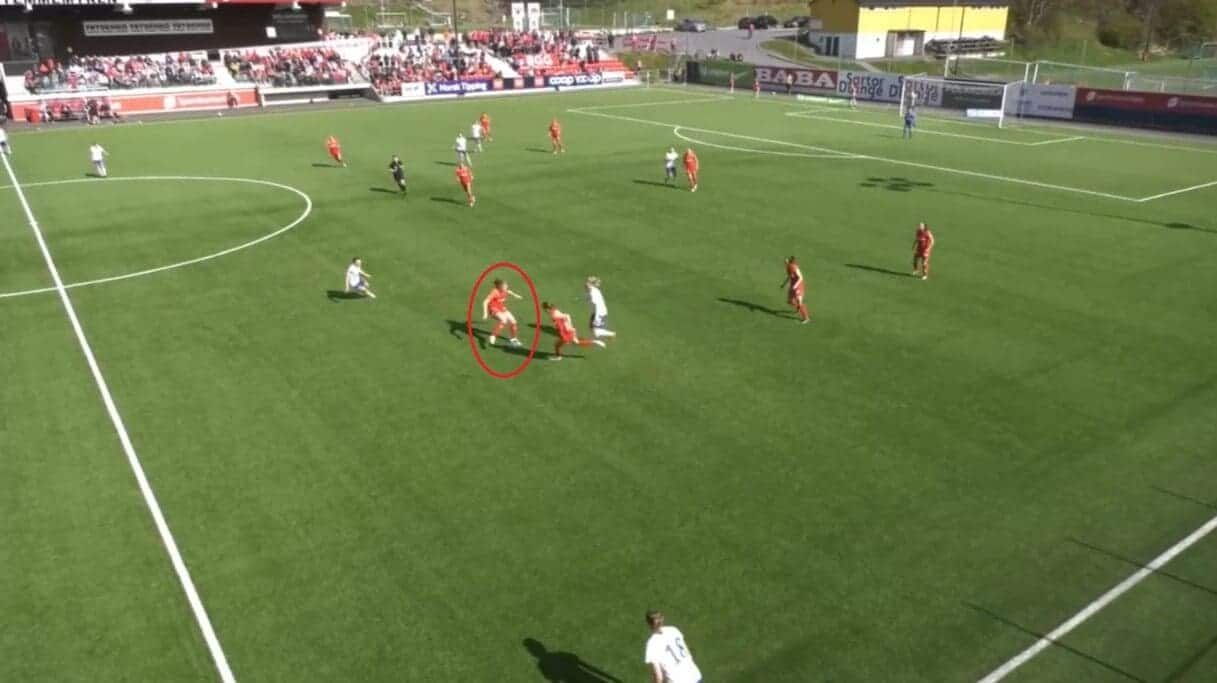
What is really obvious when watching the 17-year-old play is that she does the things that other players aren’t so interested in, such as hunting around in the middle of the field to win the ball and then move it into her teammates to advance up the field, and this makes her “a unique player” according to Norway and now-Bayern Munich Frauen right-back Tuva Hansen.
In this case, Kolbotn have lost control of the ball whilst trying to move it into space and it rolls directly into Gaupset’s path, and, whilst this is fortunate on the midfielder’s part, it was the fact that she was in the vicinity and anticipating the error that is the key point.
As a result of her ability to win possession here, Brann were able to move the ball into the path of midfielder Rakel Engesvik, who had a clear route into the final third, and that shows again how Gaupset’s ability to win the ball was critical to Brann maintaining a significant attacking threat and ultimately sealing the domestic double.
Creating options
Another area of Signe Gaupset’s game that has helped her to catch the eye is her ability to create options around the field, both in defensive and attacking situations and her awareness and ability to read the game are once again central to this being one of her strengths.
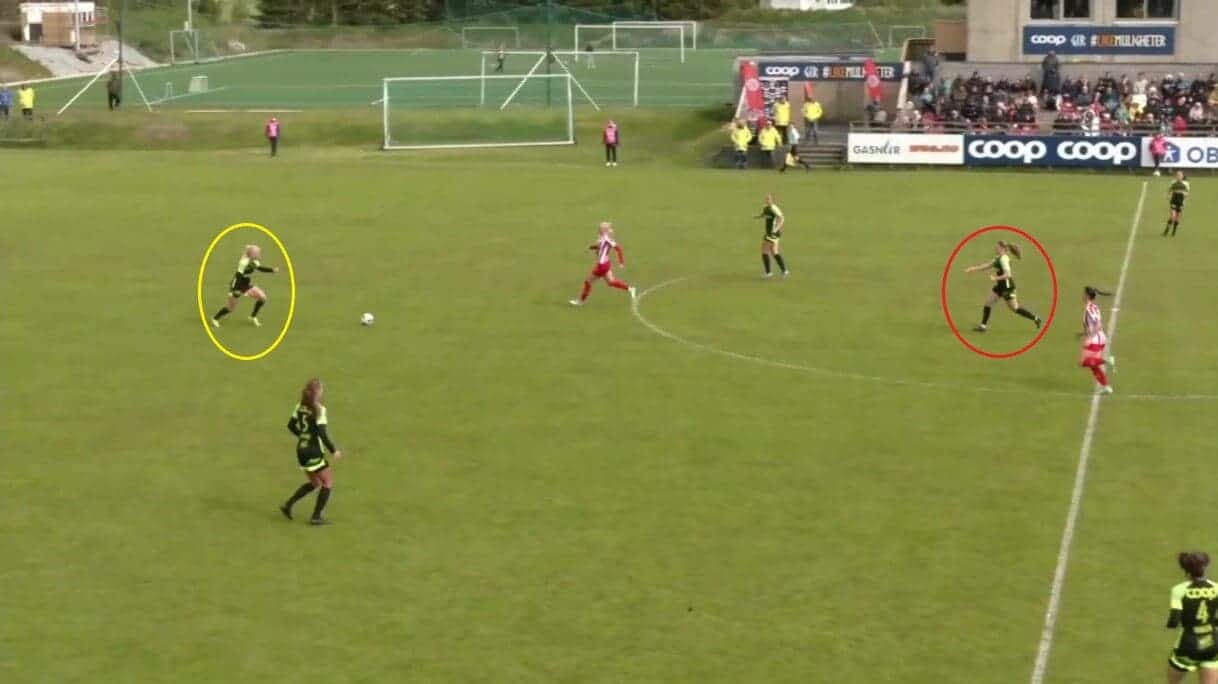
When Brann have the ball inside their own third, as is the case here, their main focus is on playing out from the back and putting pressure on their opponents as early as possible. However, for that to work, they need midfielders who are comfortable on the ball and who are capable of finding spaces around the field.
This is where Gaupset comes in, with her in the red circle here and again reading the game to see where she can have an effect on it, and what she sees here is that defender Guro Bergsvand, who joined Brighton and Hove Albion Women in January, is looking for a forward passing option in order to start an attack.
However, whilst her positioning is important here, what is really noticeable is that, before the ball comes to her, Gaupset is looking around and assessing her surroundings, working out not only where the opposing threats are but also where her own passing options could be. By doing so, she ensures that she doesn’t need to take too many touches on the ball once Bergsvand moves it towards her, which would increase the risk of Avaldsnes closing her down, and the result is that, through a combination of Marthine Østenstad and Nora Eide Lie, Brann are able to play through their opponents and into the space beyond.
Again, none of this would have been possible without Gaupset getting the detail of her contribution right, and that shows again how crucial she was last season to Brann’s success and why she will be a star of the future.
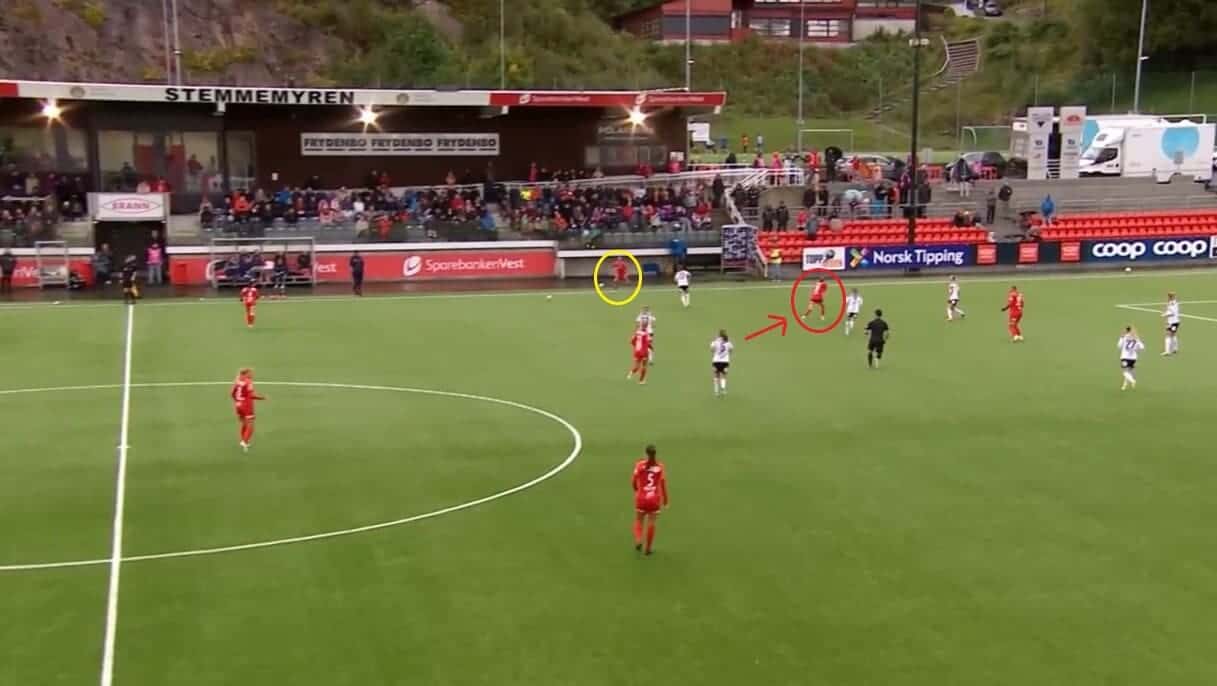
That theme of planning ahead is also prominent when looking at how Gaupset influences her side’s attacking play too, although this time it is not so much about providing the initial first passing option and instead about focusing on the second phase in order to maintain their forward momentum.
To explain, this situation shows the ball moving out to the far side of the pitch as Brann once again play out from the back, and this is where the majority of players are now focusing their attention. However, Gaupset, as the red arrow shows, is already moving towards a gap in the Rosenborg lines, having identified the space available there and recognising that it will enable her side to keep playing forwards at a high tempo and not need to take too many risks in order to do so.
Again, it is worth remembering that Rosenborg’s tactics are built around setting up with a defensive shape and then moving forwards at pace as soon as they win the ball back, but Gaupset’s run here made that harder for them to do, again providing a clear indication of how she affects opponents whilst also playing a key role in her side’s overall game plan.
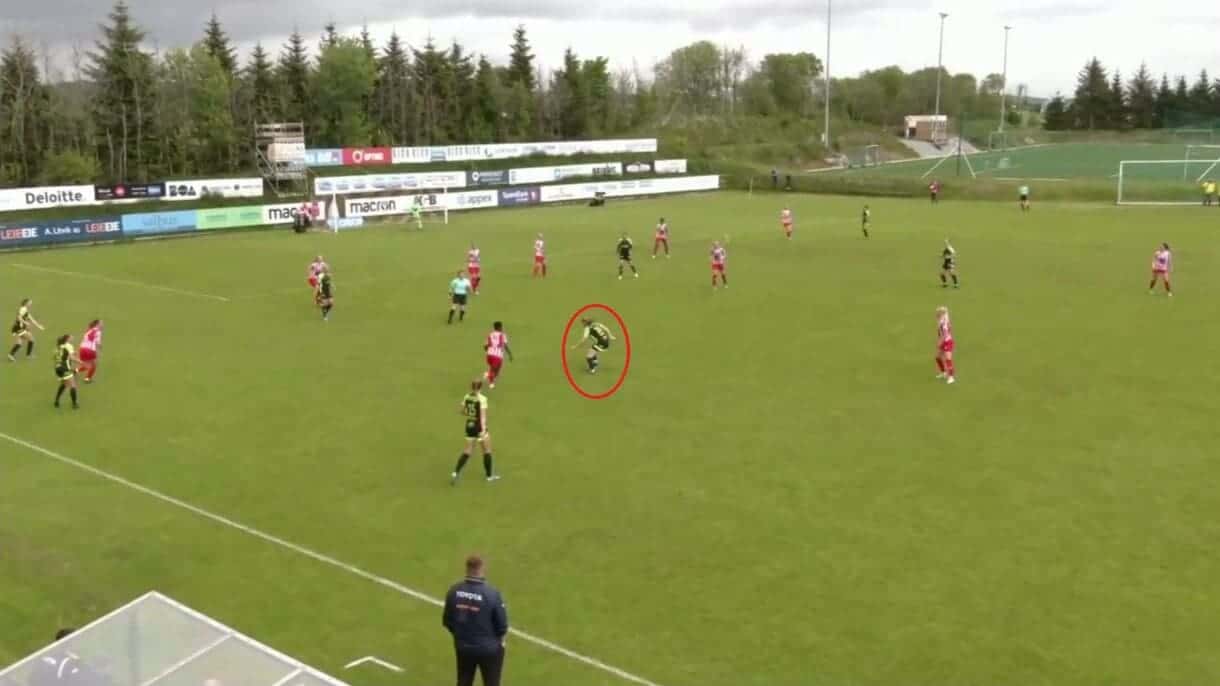
Creating options doesn’t only mean working to help teammates out though, as it can also refer to how players give themselves options when they have the ball, and that is something else that Gaupset has done well and which has benefitted her team.
Here, it is all about her body positioning and how getting that right opens up more of the pitch for her, and it comes down to the stance that she takes and where she moves the ball to. In this case, she controls the throw-in and instantly looks to get the ball out of her feet, because she knows that doing so will give her more passing options and will give her team a better chance of keeping the ball, because, should the shorter options be closed off, they can simply switch the ball to the other side of the field and launch an attack from there.
Having the ability to adjust her body positioning on the spot also makes her more difficult to take the ball off, with it clear how she looks to put her body between it and her opponent and force them to work harder to make a successful tackle. As a result, there is a higher possibility that she will be fouled, and, in this case, Avaldsnes’ Ghana midfielder Evelyn Badu has already committed to the tackle and so can’t avoid forcing Gaupset to the ground.
Building attacks
That brings the analysis nicely into the final aspect of Signe Gaupset’s game that needs to be looked at, which is her ability to build phases of play around the pitch and constantly get into positions from where she can have a direct influence on her team’s attacks.
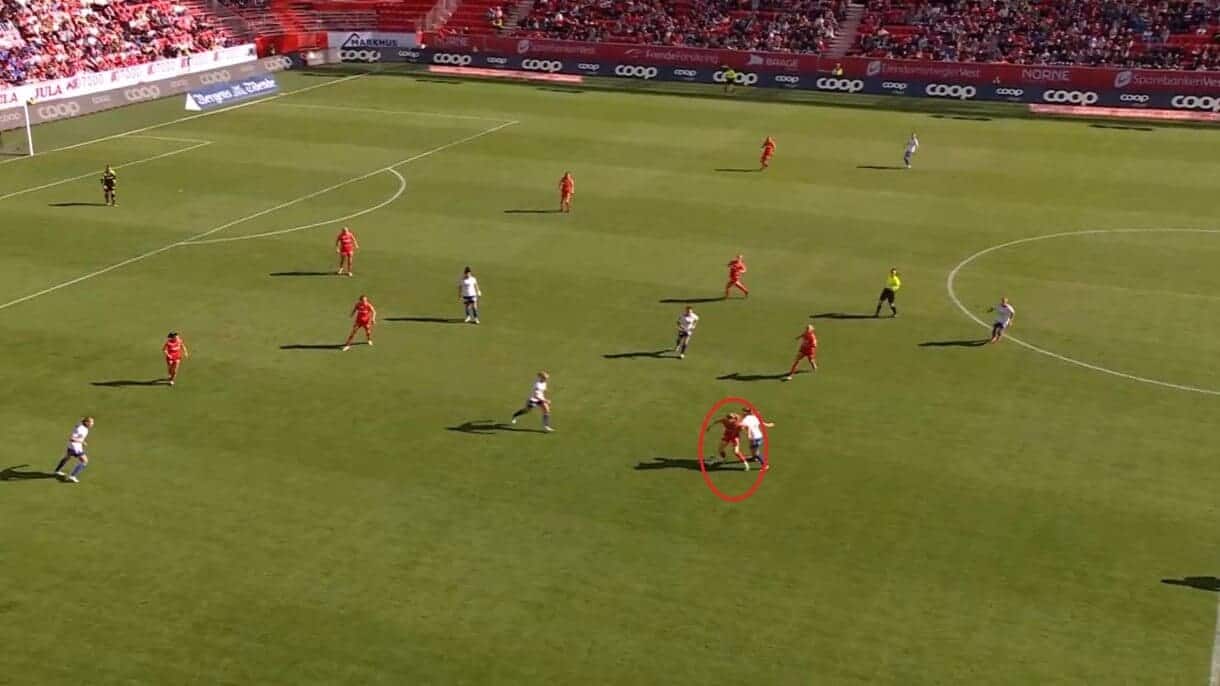
What has been essential to her ability to move the ball forwards is her combative nature, with her never afraid to engage in a duel with an opponent and again putting her body in the way to make it harder for them to take the ball off her, and the fact that she won 37.6% of her offensive duels and 69.2% of her defensive duels last season indicates just how successful she is in these 1-v-1 situations.
In this case, Vålerenga were unable to win the ball from her and she was able to advance into their half as a result, and that again highlights how dangerous she is when given any opportunity to move the ball forwards and look for a way to transfer it into the areas behind opposing defences.
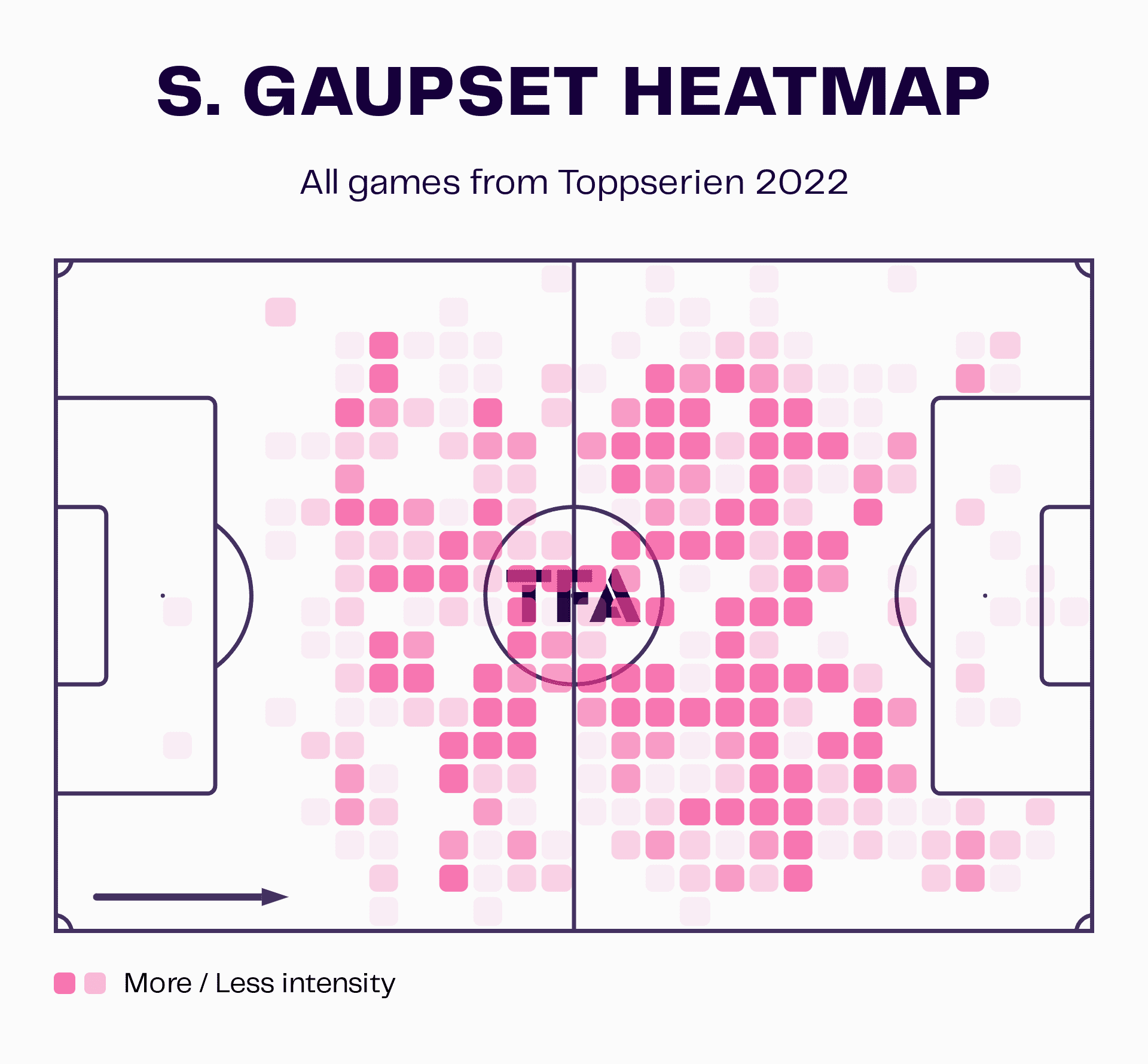
What really helped with developing that area of her game was the fact that she was asked to play in a box-to-box role by former head coach Alexander Straus and his successor Olli Harder (who took over after Straus moved to Bayern Munich), with both recognising what she can do when allowed to move around the field and how that could be harnessed to help Brann keep progressing the ball up the field and create plenty of attacking opportunities.
As a result, as this heatmap indicates, it was common to see Gaupset get into central and wide areas throughout the season, and the fact that she constantly moved around the field is another reason that she became such a tough opponent, with teams facing Brann knowing that they had to contain her but not finding a successful way to do so.
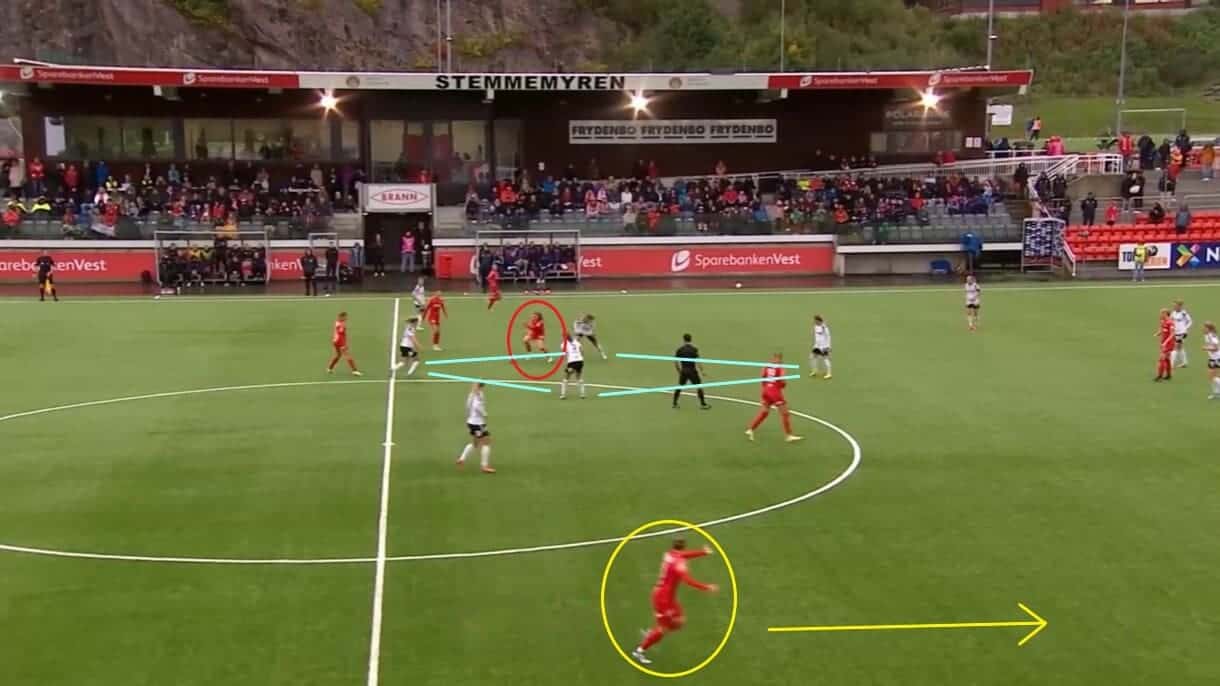
That is not to say that they didn’t try though, with Rosenborg committing four players to the midfielder here and trying to prevent her from turning and moving the ball into a dangerous area of the pitch. However, despite the best efforts of Emilie Marie Joramo, Cesilie Andreassen, Sarah Dyrehauge Hansen and Icelandic striker Selma Sól Magnúsdóttir, neither were able to win the ball, again due to Gaupset keeping her body between it and them and that always meant that Brann had the advantage here.
The problem that came from closing her down was that they lost track of where the spaces had opened up, and that was another reason that Brann were able to turn this into a goalscoring opportunity. In this case, it was Australia and former West Ham United Women player Tameka Yallop who got forward, but Brann showed time and time again that they would take advantage of spaces like this, and there is no doubt that Gaupset played a key role in building these attacks by ensuring that they used these areas to their full potential.
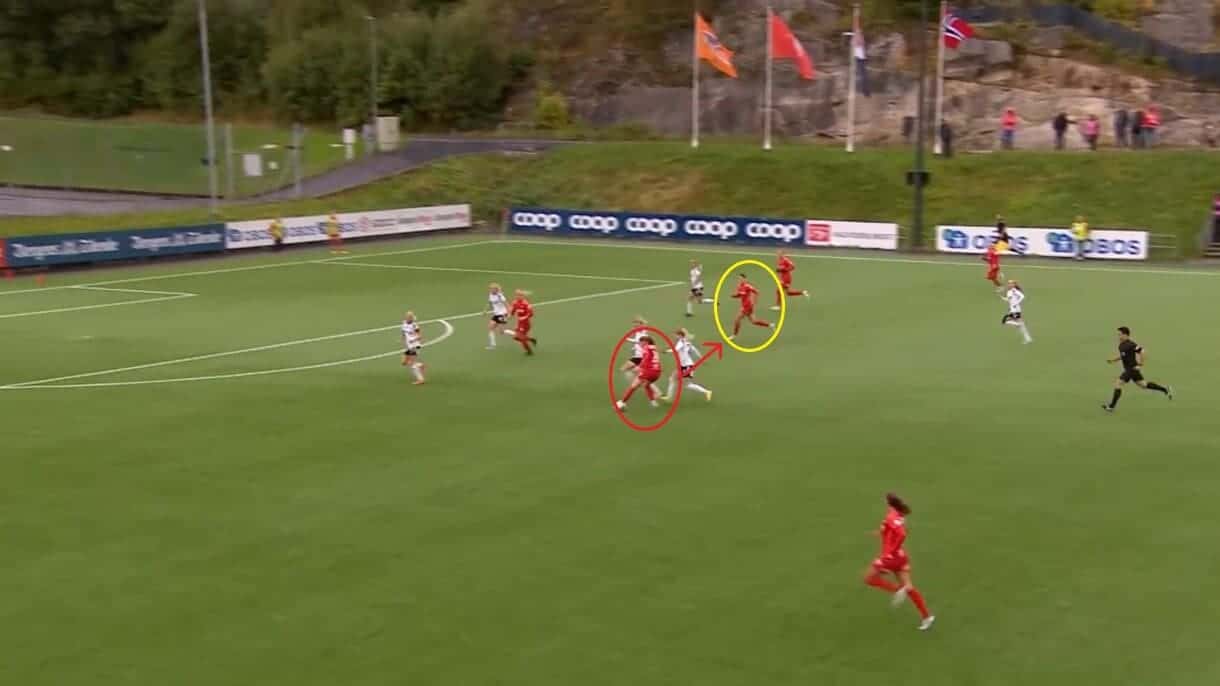
She doesn’t only pass across the pitch though and is capable of mixing up her game, with her also demonstrating on a few occasions an ability to run forwards with the ball and to not pass until the last minute. Here, Rosenborg have again moved out of line and have been caught out as a result, and that has given Gaupset all the time and space that she needs to move the ball into the path of Engesvik.
However, there are several details in this pass that make it so good. Firstly, it showed a lot of precision, with Gaupset not having a lot of room to send it through, and the risk that it would be blocked or intercepted was very high. Secondly, it showed again her decisiveness, with her identifying the chance to find her teammate and not hesitating, and that is crucial as holding onto the ball for a split second too long would have led to her being cut off. Thirdly, it showed another side to Gaupset’s game, increasing the basic picture that has been built up and displaying why, at the age of 17, she has all the tools needed to be a top player.
Player comparisons
Therefore, what has been made clear is that, as the title to this article suggests, Signe Gaupset is a player with a big future in the game. However, as with every young player, each strength is balanced out with an area that needs to be improved, and the best way to find out what Gaupset can work on is by comparing her to players in her position from Europe’s top five leagues (England’s WSL, France’s Division 1 Féminine, Germany’s Frauen-Bundesliga, Spain’s Liga F and Italy’s Serie A Femminile).

The first player is Barcelona’s Aitana Bonmatí, who, like Gaupset, is a creative midfielder who gets on the ball and makes things happen.
The areas where both players rank highly in percentile terms are shots per game and passing accuracy, and, whilst her passing strengths have been clear to see throughout this analysis, it is good to know that she is capable of testing opposing goalkeepers too and has the confidence to take matters into her own hands when there are no other options available.
Where she can improve her game when compared to Bonmatí in order to reach her level is in contributing directly to goals, because it has been shown in this analysis that she is involved in a lot of their build-up play, but this radar indicates that she doesn’t have a high expectancy for goal contributions, and those that she does contribute are even less.

Another player to compare with the young Norwegian is Real Madrid Femenino’s Teresa Abelleira, who might be more of a defensive midfielder but who also has similar percentile values for goal contributions and shots per game, showing that both of these qualities are strengths in Gaupset’s game.
However, with Abelleira taking on a defensive role on the whole for Real Madrid, this is an opportune time to examine where Gaupset is strong out of possession too, and it is clear that her percentage of defensive and aerial duels won is not too dissimilar to someone playing in one of the top five leagues in Europe, with Abelleira perhaps ranking slightly higher due to the fact that she tends to stay further back than Gaupset ordinarily does.

The final player to compare with Gaupset is Juventus Femminile’s versatile midfielder Arianna Caruso, who has been one of the Turin side’s key players this season both in deeper and advanced areas of the pitch.
The fact that she and Gaupset are both capable of dropping back and moving forward means that there is no surprise in their percentile rankings being very similar in a lot of areas. However, where Gaupset can improve to get on the same level as Caruso is by working on her goal contributions, which are once again lacking compared to the Juventus player’s.
It is worth remembering that this will be limited by the way that her team sets up tactically and what role she is asked to play, but if she wants to become a better all-round midfielder, then it is something that she can definitely improve on as she continues to develop.
Conclusion
In conclusion, this tactical analysis has looked in detail at 17-year-old Norwegian midfielder Signe Gaupset, focusing on three different elements of her game and showing through direct statistical comparisons with other players where her strengths lie and what she needs to keep working on.
All in all though, the signs are very good, and there is no doubt that she will be a future star in the women’s game. However, it is important to not get too overexcited by her potential at the moment, as that can lead to her being pushed up the age ranges before she is ready to make each step, because it would be very easy to trip up if those in charge of each stage of the international ladder don’t make sure that she is completely ready before giving her new experiences.
Nevertheless, there is definitely a lot to like about her play, and she is definitely on the right track as far as her individual development goes. At the moment, there are no transfer rumours surrounding her future, but if she keeps playing at this level, then it surely won’t be too long before the vultures do start to circle.





Comments